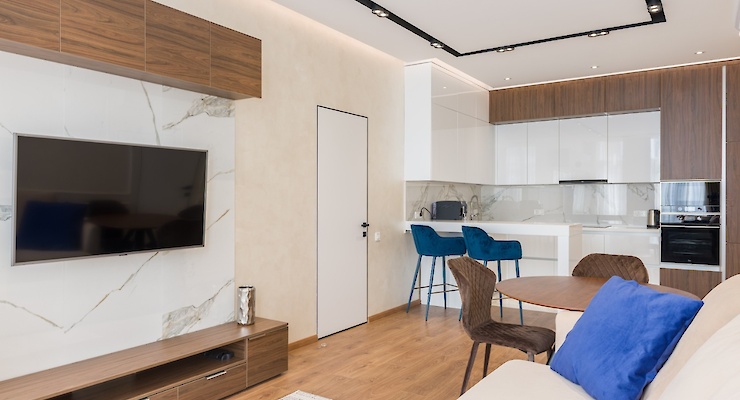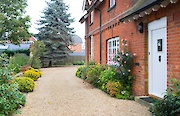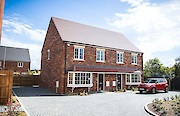


Head of Content

Mortgage Advisor & Director

New build properties are more attractive than older ones for some house buyers, but are they the best option for buy-to-let landlords? Here, you will learn whether you would be approved for a buy-to-let mortgage on a new build property, how to compare rates for them, and where to turn for expert advice.
Can you get a buy-to-let mortgage on a new build property?
Yes, but it can be more difficult than getting approved for an investment mortgage on an older property, as fewer buy-to-let mortgage lenders are available for new builds.
Some lenders consider these properties to be higher risk for landlords, but with a strong application and a decent amount of deposit, you are likely to have options.
It is, however, advisable to speak to a buy-to-let mortgage broker before you get started with your application, as they can help you narrow down your search to the ideal lenders.
Why are new builds higher risk for landlords?
New build buy-to-let properties are higher risk for landlords and buy-to-let mortgage lenders because there is less certainty around them as investments, for the following reasons:
- No rental history: Older rental properties have a stronger rental income forecast as they will have a track record of paying tenants. It is unclear whether a newly built property can generate the necessary rent to cover the mortgage payments.
- Resale potential unclear: If you are unable to generate enough rental income to keep up with your mortgage payments, the lender may have to repossess the property to resell it. As new build properties have no sale history, it is unclear whether they will retain their market value and allow the lender to recoup their debt.
- Off-plan investment risks: If the property you wish to invest in will be bought off-plan (i.e. before building work has commenced or been completed), this can make buy-to-let mortgage lenders uneasy as delays to the development work could mean your rental income won’t kick in when you need it to cover the mortgage payments.
- Teething problems: Some new build properties suffer from teething problems, such as snags and more serious issues. Although builders’ warranties usually cover the cost to rectify these things, they could disrupt the property’s rental potential.
Although these issues can put some buy-to-let mortgage providers off lending, some lenders have a higher appetite for risk and are happy to offer finance for new build rental properties.
Eligibility criteria for new build buy-to-let
The eligibility requirements for a new build buy-to-let mortgage are as follows:
- Deposit requirements: You’ll need around 25% deposit to get a buy-to-let mortgage on a new build, but putting down more can increase your chances of approval.
- Property type: There are more lenders and deals available for buy-to-let mortgages on new build houses compared to flats. Flats are considered higher risk for lenders due to the higher uncertainty around retained value and resale potential.
- Rental income: Your property will need to generate rental income at a rate that is at least 125% of the monthly mortgage payments. Having a rental income forecast of at last 145% can increase the number of lenders, rates and deals available to you.
- Personal income: Your chances of mortgage approval will likely be higher if you have personal income of at least £25,000 per year as well.
- Landlord experience: This is not essential but having landlord experience and a track record can help offset the risk posed by your new build property type.
- Credit history: It is possible to get a bad credit buy-to-let mortgage on a new build property, but severe adverse or recent issues are likely to limit your options.
- Build completion: It is more difficult to get a mortgage to purchase a buy-to-let property off-plan as some lenders will be concerned that delays to the construction work might postpone the rental income you will need to pay your mortgage.
Compare new build buy-to-let mortgage deals
Now that you have read up on the criteria for a new build buy-to-let mortgage, you can compare rates for them and Teito and choose the deal you want in real time.
As part of the service, you will be offered a free, no-obligation chat with a broker who specialises in new build buy-to-let mortgages.
Choose your preferred option below to get started:

Compare new build buy-to-let mortgages for FREE
Available lenders and interest rates
Interest rates on new build buy-to-let mortgages are higher than they would be for equivalent older properties, sometimes only slightly higher, but the exact rates and the number of lenders you can access will depend on the property type on the loan-to-value (LTV) ratio.
The tables below show the number of available lenders based on these variables.
Houses & bungalows
This tables shows the number of buy-to-let lenders for new build houses and bungalows:
|
Loan-to-Value Ratio |
Number of Lenders Available (Approx) |
|
85% |
8 |
|
80% |
20 |
|
75% |
60 |
|
70% |
70 |
|
65% |
71 |
Flats & maisonettes
This tables shows the number of buy-to-let lenders for new build flats and maisonettes:
|
Loan-to-Value Ratio |
Number of Lenders Available (Approx) |
|
85% |
2 |
|
80% |
9 |
|
75% |
47 |
|
70% |
60 |
|
65% |
63 |
|
60% |
64 |
|
50% |
65 |
Should you invest in a new build or an older property?
To help you decide whether to choose a new build or an older property for your buy-to-let investment, we have rounded up the pros and cons of new builds for landlords.
|
Advantages of New Builds for BTL |
Disadvantages of New Builds for BTL |
|
Often higher demand for newly built properties from tenants |
Fewer available mortgage lenders means the rates and deals can be less favourable |
|
Builders’ warranty protects landlords from structural issues and defects |
New builds are usually more expensive than equivalent older properties, meaning your rental profits may be lower |
|
Energy efficient which is a legal requirement for buy-to-let properties |
Snagging issues and teething problems can impact tenants and disrupt your rental income if severe |
|
Less maintenance likely required during the early years |
More stringent eligibility criteria for new builds might make mortgage approval difficult if your application is anything less than water-tight |
Why choose Teito for your buy-to-let mortgage needs?
Now that you have read up on buy-to-let mortgages for new build properties, you can get started comparing rates and deals from across the market for FREE on Teito.
When you source a mortgage with us, you will also have the option for a free, no-obligation chat with a buy-to-let mortgage specialist. Here are some of the reasons to choose us:
- You can access buy-to-let mortgage rates in seconds
- Our brokers our experts in buy-to-let and new builds
- We are five-star rated on leading review websites
- You can secure an agreement in principle in seconds
Ready to get started on your mortgage journey? Compare rates for free here.
FAQs
All buy-to-let properties need an energy performance certificate of E or above. The good news is that new builds are known for their energy efficiency, which means that your property is likely to meet this requirement with no investment needed on your part.
Choosing an Adviser
Selecting a qualified and experienced mortgage adviser is of great importance. To choose a suitable adviser, evaluate their qualifications, experience, and reputation, and ensure they are regulated by the Financial Conduct Authority (FCA).
Read reviews from previous clients and make sure they provide a clear explanation of the products and services they offer, as well as the fees and charges associated with them.

























































































































































